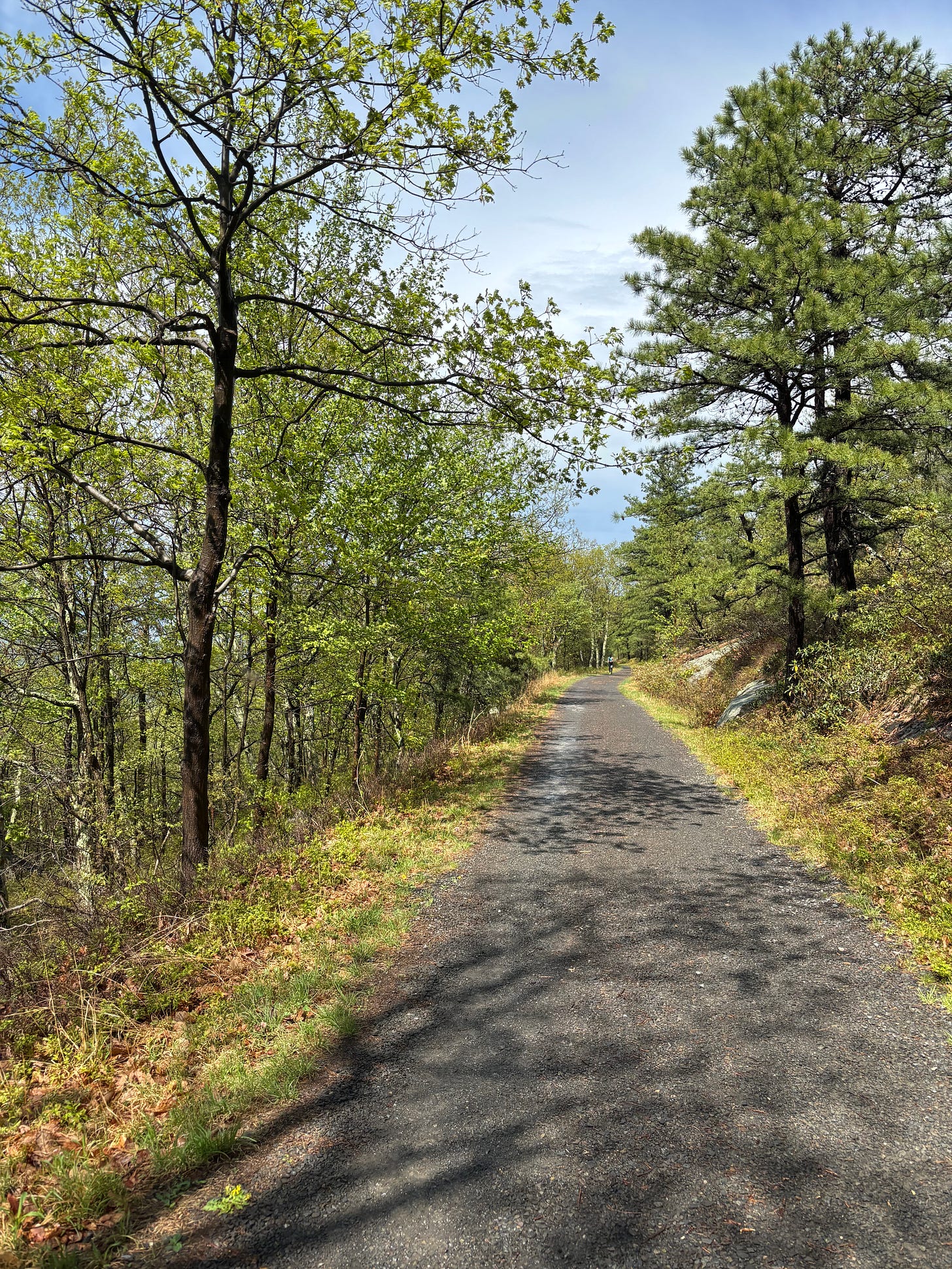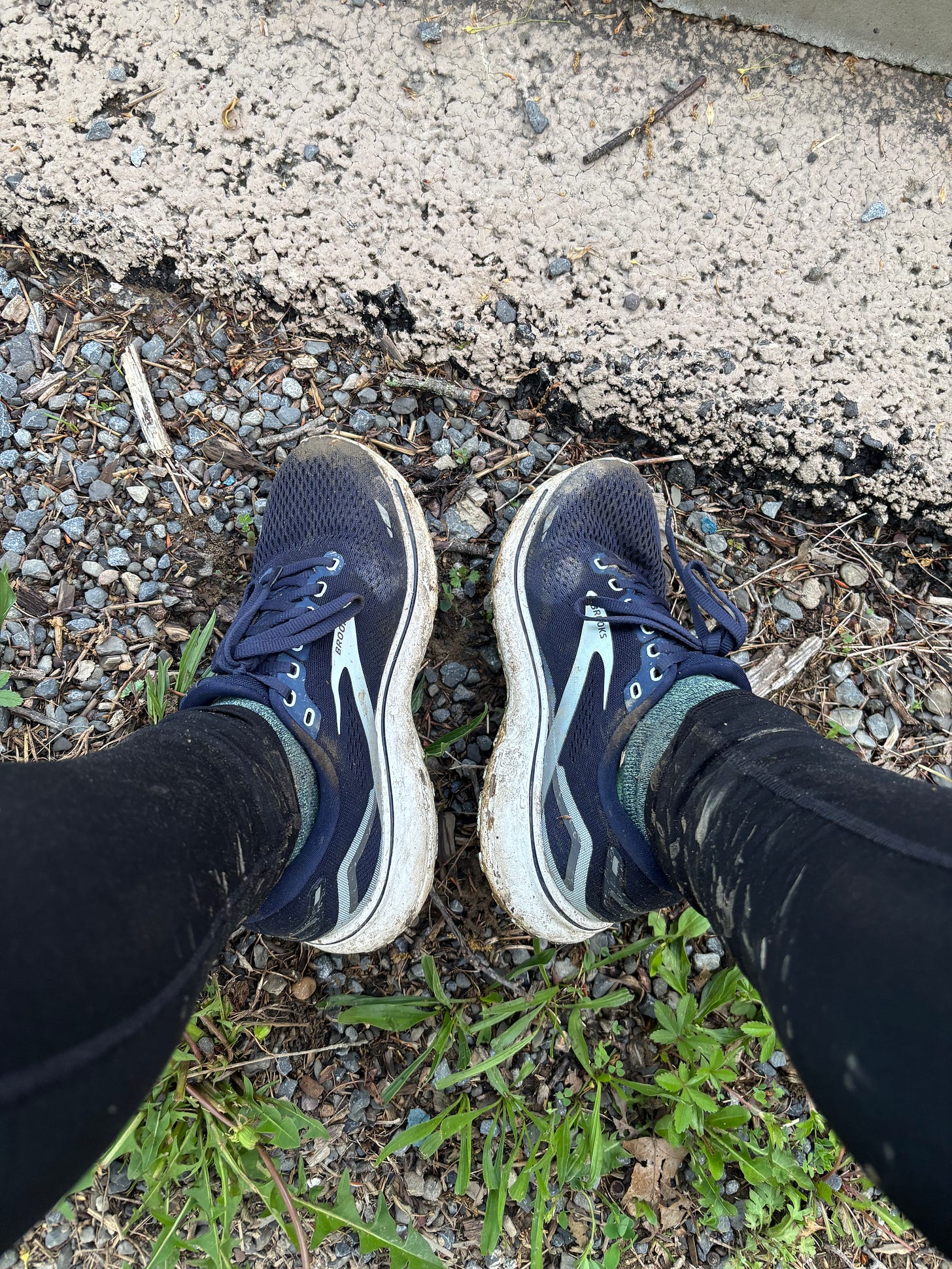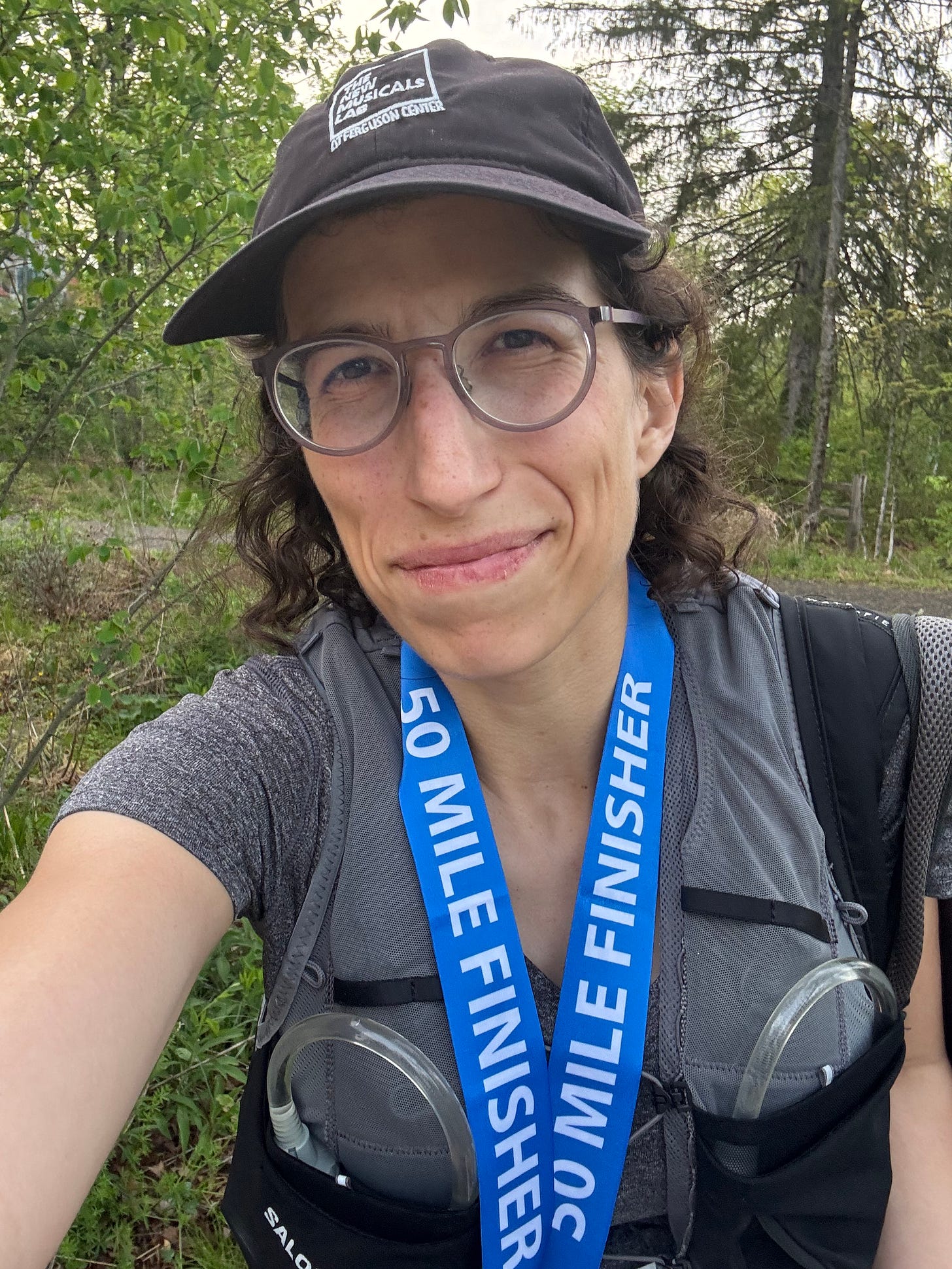Oh, hi friends!
How does it feel to run 50 miles?
How does it feel to do something you’ve never done before?
Last year, I ran my first ultramarathon — a 50K trail race in Long Island. I wrote about following pink flags to get to the finish line. One flag led to another.
This weekend, I ran my second ultramarathon — a 50-mile trail race called Rock the Ridge 2025, which goes through the Mohonk Preserve near New Paltz, New York.
50K is 31 miles.
50 miles is…50 miles.
So this race was 20 miles longer than any distance I’ve run before.
Hmm. Let’s see how this goes, I told myself.
I spent the start of this year running around 40-50 miles per week.
When I was prepping for my first marathon over 10 years ago, I said, “Training gives the rest of my life structure” — and that holds true today.
Training is so satisfying.
I make my little guides (adapted from the book Relentless Forward Progress), and add the miles I want to run to my Google Calendar.
Every day I run, I think, there’s a little win!
I’m working towards a bigger goal.
Colin and I went up to New Paltz on Friday. (Btw, Turo is a super easy way to rent a car — highly recommend! Thanks brother Eric for the rec.) We stayed at an Airbnb on a farm with chickens. We LOVED the chickens.
Rock the Ridge is billed as an “endurance challenge” (and a fundraiser for the gorgeous area).
Endurance is a great word. Endurance feels like the word of 2025.
How can we endure?
How can we keep going?
Off the runners went at 6 a.m.
The race is broken up into four legs: the first three legs are 13 miles long, and the last leg is over 10 miles.
This is important.
LESSON ONE: Don’t think about all 50 miles at once. One leg at a time.
I ticked off the first 13 miles and felt great.
Second 13 felt pretty great, too!

But the temps were much higher than usual.
78 degrees with 80 percent humidity.
I love running in the dead of winter. I haven’t acclimated to summer heat yet.
Running long distances, like most big efforts we take on in life, is so much about our mindset. I’d say it’s 80% brain, 20% physical. I made up those numbers, but they feel right to me.
So much is about how we prepare, how we approach, how we problem solve.
I just didn’t think there would be quite so many problems to solve during this race…
And yet I didn’t know there would be so many solutions, either…
Drink more water from my vest. (I use this one.) Drink more electrolytes at the aid stations. Eat something every 45 minutes even when I don’t want to.
At the halfway point, there was PB&J, soup, snacks, and more.
My sweat was feeling salty. This pickle brought me back to life.
And then, boy oh boy, the back half of this race was humbling.
Running on tired legs is one thing. I can do that.
But running with intense nausea — that was new!
And yet that’s what I did…for the next seven hours.
Then something else exciting happened.
The humidity broke!
Because a giant thunderstorm rolled in through the hills.
Thunder, lightning, drama.
I hid under a tree canopy with a cyclist who also got caught in the storm, then pressed on.
I wish I had photos from this time but my phone was soaked and there was no cell service.
Made it to the next aid station, where a ranger was holding all runners to “shelter in place” for 40 minutes because lightning isn’t good!!!
We huddled under foil space blankets and refilled our water bottles and could only chuckle.
Humidity was too much? Well then, how about a monsoon?
The storm eased, runners took off, the sun reemerged.
LESSON TWO: Everything is temporary.
So here’s where all the work-life-running metaphors come in.
Because I felt so blergh, my mind could only hold one benchmark at a time.
Get to the next aid station.
Sometimes it was two miles away, sometimes four miles away, but that became my goal.
Just one more.
Because at the aid station, I could get more water, electrolytes, snacks, and make a few jokes with the incredibly nice volunteers, who spent their entire days tending to a few hundred crazy runners doing something insane.
At the end of the third leg — around 40 miles — I sat in a chair and thought, Well, I’m definitely finishing, but it won’t be easy.
I could hear myself narrativizing the race as I was running it.
We tell ourselves stories about where we are to understand where we’re going.
LESSON THREE: Tiny progress is progress.
I started counting: walk 30 seconds, run 30 seconds, walk 30 seconds, run 30 seconds.
This got me moving.
I also started a list of everything going right: it was less humid, I was staying hydrated, my feet were blister-free despite being my shoes and socks being completely drenched (I switched to these toe socks a few months ago), my legs felt strong, miracle of miracles I wasn’t chafing, I wasn’t hit by lightning, I packed super smart in my vest and drop bags, the course was well-marked, the runners were inspiring, I was already 10 miles further than I’d ever gone…
The list of things going right was so long.
Yet I easily could have ignored them all.
Why do we ignore what’s working and instead highlight what isn’t?
Sure, I felt like I wanted to puke for seven hours, but I was still moving.
And I started to think about all the times in our lives when we feel like we’re not moving. When growth is slow. When there are no mile markers or aid stations to notch our progress.
That’s the worst feeling: stuck in a tunnel with no windows and no end in sight.
And I started to think about all the ways we can, perhaps, create our own markers, our own aid stations. How we can make our projects concrete even when the conditions are always changing. How we can learn to rely on other people for support and advice. How we can create our own benchmarks. How we can put in drops of effort every day to remind ourselves we are not in a motionless process, but an active one.
The hills kept coming (the elevation gain on this course is 4,619 feet, which is about four times the elevation I usually get in a week!).
But I kept moving. Solving problems.
Take off the hat. Try these electrolytes instead. Pop a Tums. More water. Oh look, another Port-a-Potty! Say hi to that dog. Pop a Pepto. Cheer the leaders who loop by on their final leg. Stretch on that tree stump. Chat with this new friend. Take in the view.
Progress, progress, progress.
After all that — and a lot more, but I won’t bore you!! — I crossed the finish line.
Thrilled, exhausted, happy, depleted.
Over 13 hours on the course. Taking it one leg, one aid station, one step at a time.
Strava even says I ran 54.22 miles. Four bonus miles!!
Maybe I needed to experience a dramatic and hard race, I thought.
Because this is all going into my musical!
(These are the sick thoughts a writer has anytime something mildly interesting happens: Gonna use it.)
I’ll leave you with this:
If you think you can’t do something, you probably won’t.
If you think you can do something, you probably will.
How does it feel to run 50 miles?
How does it feel to do something you’ve never done before?
It feels like enduring.
It feels like being alive.
What’s next?
You tell me.
Special thanks to crew husband Colin for keeping me alive daily, Abby Reisner for truly invaluable advice, Marissa for mid-race texts, Aransas for every Friday long run, and MOM and friends for chatting with me through many afternoon runs over the last few months.
Onward!!










You are my hero! Thank you for the inspiration!
inspiring as ever! i especially loved the pickle bringing you back to life :)